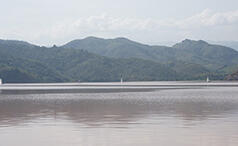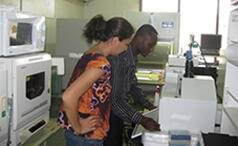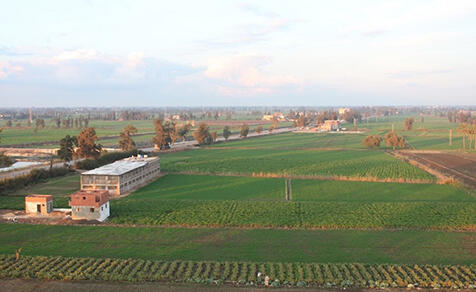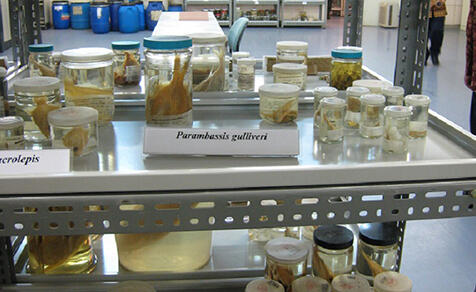Earthquake and Tsunami Disaster Mitigation - Global benefits from Japan-Peru research -
Earthquake and Tsunami Disaster Mitigation - Global benefits from Japan-Peru research -
Research Fields and Areas
Disaster Prevention and Mitigation
 In March 2011, Japan was hit by the Tohoku Region Pacific Coast Earthquake, resulting in enormous damage. By their very nature, natural disasters are extremely difficult to predict, and we cannot tell for certain when an earthquake or tsunami will strike. However, this earthquake provided a chilling reminder of how important it is for predictions and disaster prevention to be as good as possible. In addition to individuals remaining alert to disaster prevention, experts need to work on analyzing subsurface structure and sea-floor topography, and researching technology for quake-resistant architecture. Japan is situated in a plate boundary zone where tectonic plates converge and there are frequent major earthquakes in coastal areas or offshore. Peru is another country in a similar zone, and suffered a magnitude 7.9 event in 2007. That earthquake hit the city of Pisco, resulting in a disaster that produced over 500 fatalities, destroyed large numbers of homes, and affected over 80,000 people. Peru and Japan share the need for action to mitigate further earthquake and tsunami disasters.
In March 2011, Japan was hit by the Tohoku Region Pacific Coast Earthquake, resulting in enormous damage. By their very nature, natural disasters are extremely difficult to predict, and we cannot tell for certain when an earthquake or tsunami will strike. However, this earthquake provided a chilling reminder of how important it is for predictions and disaster prevention to be as good as possible. In addition to individuals remaining alert to disaster prevention, experts need to work on analyzing subsurface structure and sea-floor topography, and researching technology for quake-resistant architecture. Japan is situated in a plate boundary zone where tectonic plates converge and there are frequent major earthquakes in coastal areas or offshore. Peru is another country in a similar zone, and suffered a magnitude 7.9 event in 2007. That earthquake hit the city of Pisco, resulting in a disaster that produced over 500 fatalities, destroyed large numbers of homes, and affected over 80,000 people. Peru and Japan share the need for action to mitigate further earthquake and tsunami disasters.

Principal investigator (Japan):Professor YAMAZAKI Fumio
Department of Urban Environment Systems, Graduate School of Engineering, Chiba University
Graduated from Dept. of Civil Engineering, University of Tokyo (B.Eng., M.Eng.). Employed as Civil Engineer and Research Engineer by Shimizu Corporation. Awarded D.Eng. by University of Tokyo. Before taking his current position, appointed Associate Professor, Institute of Industrial Science, University of Tokyo, then Professor, Asian Institute of Technology (AIT), Bangkok. Research Fields include urban infrastructure systems and earthquake engineering.
 Japan perspective
Japan perspective
Using Japanese technology to global benefit
The March 2011 event in Japan was the latest in a long series of earthquake and tsunami disasters. Japan has accumulated a great deal of sophisticated disaster prevention technology, and is keen to help mitigate damage from earthquakes around the world.
Enhancing geo-science and mitigation technology
Studying earthquakes that occur in Peru, situated like Japan in a subduction zone, provides the opportunity to gain new knowledge that can significantly enhance Japan's geo-science and disaster mitigation technology.

Principal investigator (Peru):Dr. Ing. Carlos Zavala Toledo
Professor. National University of Engineering, Lima, Peru Director, CISMID
(Japan-Peru Center for Earthquake Engineering Research and Disaster Mitigation)
Graduated from National University of Engineering, Lima, Peru. Completed D.Eng. at Graduate School of Engineering, University of Tokyo and appointed Associate Professor of National University of Engineering, Peru, before being named Director of CISMID.
 Peru perspective
Peru perspective
Working together to mitigate local disasters
Peru and neighboring Chile have been hit by many large earthquakes over the years, including the major earthquakes that hit Peru in 2007 and Chile in 2010. These experiences have given the Peruvian people and their political representatives a strong concern for disasters, and a keen interest in technology that can mitigate the impact of such events, including enhanced anti-seismic technology and earthquake prediction.
Project summary
In addition to utilizing Japan's existing technology to contribute to disaster mitigation in Peru, this project involving researchers from Japan and Peru will generate new knowledge that enhances mitigation technology. Both countries are located in similar seismic environments, so both benefit from sharing data and knowledge of subduction-zone events. The project is organized into five research groups handling specific topics.
- A.Seismic Motion and Geotechnical Issues
- Source modeling and prediction of seismic motion
- Microzonation based on seismic and microtremor observations
- Risk assessment of slope failures
- B.Tsunami Simulation and Damage Mitigation
- Tsunami source, propagation, and impacts
- Tsunami hazard and impacts mapping
- Implementation of tsunami disaster mitigation technology
- C.Enhancement of Seismic Resistance of Buildings
- Develop database of structural test results for masonry buildings
- Develop seismic diagnosis and retrofit technologies
- Assessment and retrofit of historical buildings
- D.Geo-spatial Database and Damage Assessment
- Development of geo-spatial database
- Damage detection using satellite images
- Damage assessment for scenario earthquakes
- E.Development of Disaster Mitigation Plan
- Develop plans based on findings of the other groups
- Focus on land use, people's awareness, and emergency response



 Prof.YAMAZAKI
Prof.YAMAZAKI
 "Peru is one of several South American countries facing frequent large earthquakes with magnitudes of 7 or greater. The magnitude 7.7 Ancash earthquake in 1970 resulted in over 70,000 fatalities, and there was a magnitude 8 earthquake in 2001. In 2007, the city of Pisco suffered substantial damage from an earthquake and tsunami of 1-3 meters, resulting in over 500 fatalities, 15,000 injuries, and the destruction of over 40,000 homes. Estimates suggest that more than 80,000 people lost their homes."
"Peru is one of several South American countries facing frequent large earthquakes with magnitudes of 7 or greater. The magnitude 7.7 Ancash earthquake in 1970 resulted in over 70,000 fatalities, and there was a magnitude 8 earthquake in 2001. In 2007, the city of Pisco suffered substantial damage from an earthquake and tsunami of 1-3 meters, resulting in over 500 fatalities, 15,000 injuries, and the destruction of over 40,000 homes. Estimates suggest that more than 80,000 people lost their homes."

 Prof.YAMAZAKI
Prof.YAMAZAKI
"Peru's history of earthquake disasters means that people have a heightened awareness of the need for action. Peru is also a country with strong links to Japan, and many Peruvians are of Japanese descent."

 Prof.YAMAZAKI
Prof.YAMAZAKI
 "Research into earthquakes using case studies requires large amounts of data. Instead of just one country doing research by itself, countries subject to similar earthquake mechanisms can benefit by collaborating. Such joint research leads to more accurate predictions and enhances disaster prevention, which benefits many countries around the world, not just the research partners. When Japanese researchers work together with their Peruvian counterparts on local observations and structural testing, that helps to train future researchers, transfer technology, and contributes to building self-reliant research capacity in Peru."
"Research into earthquakes using case studies requires large amounts of data. Instead of just one country doing research by itself, countries subject to similar earthquake mechanisms can benefit by collaborating. Such joint research leads to more accurate predictions and enhances disaster prevention, which benefits many countries around the world, not just the research partners. When Japanese researchers work together with their Peruvian counterparts on local observations and structural testing, that helps to train future researchers, transfer technology, and contributes to building self-reliant research capacity in Peru."

 Prof.YAMAZAKI
Prof.YAMAZAKI
"The best way to make effective use of the knowledge and experience gained through research is to involve local communities and businesses at the research stage. However, despite people having a high awareness of earthquakes, it is still not easy to translate that to practical action. We are investigating ways of raising awareness of disaster preparedness and encouraging public-private sector partnerships."

 Prof.YAMAZAKI
Prof.YAMAZAKI
"For instance, our research into seismic motion and geotechnical issues should enable assessment of potential construction sites to give advice like 'This slope is relatively safe; it's very solid and can withstand a seismic intensity (shindo) 5 earthquake,' or 'This is a bad place to build a house; the slope is soft and would be at risk even with a seismic intensity (shindo) 4 quake.'"

 Prof.YAMAZAKI
Prof.YAMAZAKI
"Through this research we are building strong partnerships between the researchers and people associated with the Peruvian government agencies. That provides the foundation for a self-reliant entity for disaster prevention research in Peru that can address earthquake and tsunami issues. We will continue to ensure a proper follow-up after this project comes to an end. We also plan to publicize the research outcomes and transfer the technology to other Asia-Pacific nations, particularly those in Latin America, through means such as direct training."

Disaster Prevention and Mitigation
 Republic of Peru
Republic of Peru
Case Studies
Contact Us
Japan Science and Technology Agency (JST)
Department of International Affairs
SATREPS Group
TEL : +81-3-5214-8085
Related articles
-
Disaster Prevention and Mitigation

 Republic of Cameroon
Republic of Cameroon
Investigating the silent seeds of disaster in two lakes
- Saving lives from disasters caused by CO2 - -
Infectious Diseases Control

 Republic of Ghana
Republic of Ghana
Developing new medicines for infectious diseases
- Studies based on Ghanaian medicinal plants - -
Environment / Energy
(Global-scale environmental issues)
 Arab Republic of Egypt
Arab Republic of Egypt
Water conservation in the Nile basin
- Saving water provides resources to turn desert into farmland - -
Bioresources

 Republic of Indonesia
Republic of Indonesia
World-class Microbial Resource Center
- Re-evaluating and developing bioresources in Indonesia -














